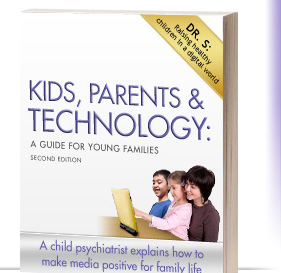“Children’s uses of technology at home can too easily rob families of unique bonding opportunities and expose kids to immediate and future dangers. Parents are already worrying about unorganized unsupervised use, but it seems so pervasive in our culture that most don’t know what to do and where to start. Just eliminating all technology does not seem right to many,” according to Dr. S, a distinguished Chicago child psychiatrist and author of the newly-released guide for parents.
Parents are right to worry. While they can become more stressed when their schedules do not lighten up to accommodate the months and months of school-free kids, media like TV, MP3 players, baby videos, smartphones, computers, video games, and computerized toys and dolls seem extremely convenient and seductive baby-sitters. But in the long run, most parents rightly sense that these can be harmful to kids and families.
In fact, increasing home technology use does isolate family members. According to research, families with more media use end up less close and kids less happy. In the US, recent Kaiser Family and Pew Foundations studies show that at least 20% of older children end up spending over 130 hours weekly with media and more time texting than actually talking on the phones . The danger of Internet addiction looms large: in South Korea, the government is actually stepping in to aid the nearly two million Internet-addicted teens and young adults. Studies also show that by the time a child reaches adolescence, parents can do less and less to influence healthy uses of technology or prevent excessive and inappropriate consumption.
Parents want help. Time is running out as kids become increasingly isolated, family life declines, and technology-soaked and their chaotic media consumption continues. “It is urgent to protect our families and guide our kids. These media experiences are changing how kids’ brains are wired. Parents should not miss opportunities that summertime brings to cement family life and prevent bad outcomes. There is plenty that is positive and helpful parents can actually do, once they gain the confidence and adopt a new mind set,” according to Dr. S.
“Families are already missing out on benefits technology has to offer year-round. But – good news — they can catch up by using increased summer leisure time and longer daytime hours to make technology an asset and create a healthy balance in child rearing and family relationships. Parents of young kids can use the summer to start a major project of initiating healthy media consumption and avoiding improper uses that will continue year-round,” according to Dr. S, who recommends these steps to parents:
1. Rethink the role of technology and assume leadership of your family in resetting goals of media use in your home. Some families would require radical makeovers.
2. Consult with each child’s teachers, librarians, other parents, and other credible resources, especially if the child has special needs.
3. Discover and harvest online and other resources to make sure they are good for your children and enhance Growth Opportunities — Family relationships, Socialization, Values Education, Education Enrichment, and Entertainment.
4. Decide on the proper media balance for each child according to age and specific needs. If a piece of technology does not serve child development or healthy family life, it does not belong in your home. Think of technology devices as home appliances, not toys.
5. Collaborate with the child and other family members to organize each child’s media consumption and your own involvement into weekly plans of balanced Growth Opportunities that suit the child’s age and individual needs. Keep track of amount and kind of daily use and make sure kids adhere to the plan. Review and refine the plan year-round. This may seem like more work right now, but in the long run you will save yourself and your kids untold problems later and bring many benefits.
6. Discourage solitary media use and avoid shutting out kids when you yourself use media such as cell phones and texting yourself. Encourage together uses of media, like video games and watching TV as a family.
7. Use summer travel to put your new plan into operation. Whenever possible, plan family trips together online and invent other joint activities like setting up photo albums or educational projects like studying the history of points of interest and travel destinations or starting collections like rocks or sea shells. On long road trips, forbid excess media use like texting or other smartphone uses. Substitute family games, singing together, conversations, and other fun engagements with kids for backseat TV or video or isolating earphone music.
8. Establish media-free zones and media-free times – like weekends– for all to follow. Spend more active time outdoors with the kids, and leave your own cell phone home.
9. Growing up with ubiquitous electronic input is harming imagination and creativity and leaving kids shallow, unable to self-sooth, stimulus hungry, and easily bored. Consider replacing the electronic clutter in their lives with appreciating their inner lives and the value of being fully present during quiet private time alone. Encourage thinking, observing, and imagination. Teach quiet times together and silently appreciate a beautiful natural scene, art, performance, or music. You too may need to learn this step first.
Families that do not have an organized approach to media consumption put kids at risk and miss out on great “Growth Opportunities”. With a correct balance and proper parental supervision tailored to the child’s age, technology can actually enhance children’s development and family life.
According to Dr. S, “Planning children’s (and parents’) media consumption has to become a priority as important as planning nutrition and education, and I hope that smart parents are beginning to catch on. I am personally passionate about this issue because it is so important for our families’ health and the future of our society.” But parents must start early – with infants, toddlers, preschoolers, and grade school kids – to make balanced technology consumption a healthy ongoing part of family life. By the time the child is a teen, he will have good habits.
KIDS, PARENTS & TECHNOLOGY: A GUIDE FOR YOUNG FAMILIES (ISBN 9780557194827), available everywhere in paperback and in all electronic forms, is child- and family-centered, positive, and innovative. It is the first ever comprehensive guide for parents, grandparents, therapists, and all others interested in healthy family life and child rearing. Age-specific chapters give detailed instructions and hands-on tools to shape kids’ technology consumption (see www.MyDigitalFamily.org ). This is not yet another “Nine Easy Ways to…” — type approach promising easy solutions to complex problems. It is a thoughtful and comprehensive work by a wise and devoted doctor who asks parents to make enduring commitments to make life-altering changes in their families’ lives.
SOURCES:
http://www.MyDigitalFamily.org
http://www.nytimes.com/2010/05/29/world/asia/29game.html?emc=tnt&tntemail1=y
http://www.nydailynews.com/lifestyle/2010/04/27/2010-04-27_college_students_are_addicted_to_social_media_and_even_experience_withdrawal_sym.html
http://www.usatoday.com/news/health/2010-04-26-rmovies26_ST_N.htm?csp=usat.me
http://www.pewinternet.org/Presentations/2009/17-Teens-and-Social-Media-An-Overview.aspx
http://www.kff.org/entmedia/entmedia012010nr.cfm
http://www.nytimes.com/2010/05/14/technology/personaltech/14talk.html?emc=tnt&tntemail1=y



In the Good Ol’ Cybertime: An Urgent Alert to Parents
“Children’s uses of technology at home can too easily rob families of unique bonding opportunities and expose kids to immediate and future dangers. Parents are already worrying about unorganized unsupervised use, but it seems so pervasive in our culture that most don’t know what to do and where to start. Just eliminating all technology does not seem right to many,” according to Dr. S, a distinguished Chicago child psychiatrist and author of the newly-released guide for parents.
Parents are right to worry. While they can become more stressed when their schedules do not lighten up to accommodate the months and months of school-free kids, media like TV, MP3 players, baby videos, smartphones, computers, video games, and computerized toys and dolls seem extremely convenient and seductive baby-sitters. But in the long run, most parents rightly sense that these can be harmful to kids and families.
In fact, increasing home technology use does isolate family members. According to research, families with more media use end up less close and kids less happy. In the US, recent Kaiser Family and Pew Foundations studies show that at least 20% of older children end up spending over 130 hours weekly with media and more time texting than actually talking on the phones . The danger of Internet addiction looms large: in South Korea, the government is actually stepping in to aid the nearly two million Internet-addicted teens and young adults. Studies also show that by the time a child reaches adolescence, parents can do less and less to influence healthy uses of technology or prevent excessive and inappropriate consumption.
Parents want help. Time is running out as kids become increasingly isolated, family life declines, and technology-soaked and their chaotic media consumption continues. “It is urgent to protect our families and guide our kids. These media experiences are changing how kids’ brains are wired. Parents should not miss opportunities that summertime brings to cement family life and prevent bad outcomes. There is plenty that is positive and helpful parents can actually do, once they gain the confidence and adopt a new mind set,” according to Dr. S.
“Families are already missing out on benefits technology has to offer year-round. But – good news — they can catch up by using increased summer leisure time and longer daytime hours to make technology an asset and create a healthy balance in child rearing and family relationships. Parents of young kids can use the summer to start a major project of initiating healthy media consumption and avoiding improper uses that will continue year-round,” according to Dr. S, who recommends these steps to parents:
1. Rethink the role of technology and assume leadership of your family in resetting goals of media use in your home. Some families would require radical makeovers.
2. Consult with each child’s teachers, librarians, other parents, and other credible resources, especially if the child has special needs.
3. Discover and harvest online and other resources to make sure they are good for your children and enhance Growth Opportunities — Family relationships, Socialization, Values Education, Education Enrichment, and Entertainment.
4. Decide on the proper media balance for each child according to age and specific needs. If a piece of technology does not serve child development or healthy family life, it does not belong in your home. Think of technology devices as home appliances, not toys.
5. Collaborate with the child and other family members to organize each child’s media consumption and your own involvement into weekly plans of balanced Growth Opportunities that suit the child’s age and individual needs. Keep track of amount and kind of daily use and make sure kids adhere to the plan. Review and refine the plan year-round. This may seem like more work right now, but in the long run you will save yourself and your kids untold problems later and bring many benefits.
6. Discourage solitary media use and avoid shutting out kids when you yourself use media such as cell phones and texting yourself. Encourage together uses of media, like video games and watching TV as a family.
7. Use summer travel to put your new plan into operation. Whenever possible, plan family trips together online and invent other joint activities like setting up photo albums or educational projects like studying the history of points of interest and travel destinations or starting collections like rocks or sea shells. On long road trips, forbid excess media use like texting or other smartphone uses. Substitute family games, singing together, conversations, and other fun engagements with kids for backseat TV or video or isolating earphone music.
8. Establish media-free zones and media-free times – like weekends– for all to follow. Spend more active time outdoors with the kids, and leave your own cell phone home.
9. Growing up with ubiquitous electronic input is harming imagination and creativity and leaving kids shallow, unable to self-sooth, stimulus hungry, and easily bored. Consider replacing the electronic clutter in their lives with appreciating their inner lives and the value of being fully present during quiet private time alone. Encourage thinking, observing, and imagination. Teach quiet times together and silently appreciate a beautiful natural scene, art, performance, or music. You too may need to learn this step first.
Families that do not have an organized approach to media consumption put kids at risk and miss out on great “Growth Opportunities”. With a correct balance and proper parental supervision tailored to the child’s age, technology can actually enhance children’s development and family life.
According to Dr. S, “Planning children’s (and parents’) media consumption has to become a priority as important as planning nutrition and education, and I hope that smart parents are beginning to catch on. I am personally passionate about this issue because it is so important for our families’ health and the future of our society.” But parents must start early – with infants, toddlers, preschoolers, and grade school kids – to make balanced technology consumption a healthy ongoing part of family life. By the time the child is a teen, he will have good habits.
KIDS, PARENTS & TECHNOLOGY: A GUIDE FOR YOUNG FAMILIES (ISBN 9780557194827), available everywhere in paperback and in all electronic forms, is child- and family-centered, positive, and innovative. It is the first ever comprehensive guide for parents, grandparents, therapists, and all others interested in healthy family life and child rearing. Age-specific chapters give detailed instructions and hands-on tools to shape kids’ technology consumption (see www.MyDigitalFamily.org ). This is not yet another “Nine Easy Ways to…” — type approach promising easy solutions to complex problems. It is a thoughtful and comprehensive work by a wise and devoted doctor who asks parents to make enduring commitments to make life-altering changes in their families’ lives.
SOURCES:
http://www.MyDigitalFamily.org
http://www.nytimes.com/2010/05/29/world/asia/29game.html?emc=tnt&tntemail1=y
http://www.nydailynews.com/lifestyle/2010/04/27/2010-04-27_college_students_are_addicted_to_social_media_and_even_experience_withdrawal_sym.html
http://www.usatoday.com/news/health/2010-04-26-rmovies26_ST_N.htm?csp=usat.me
http://www.pewinternet.org/Presentations/2009/17-Teens-and-Social-Media-An-Overview.aspx
http://www.kff.org/entmedia/entmedia012010nr.cfm
http://www.nytimes.com/2010/05/14/technology/personaltech/14talk.html?emc=tnt&tntemail1=y